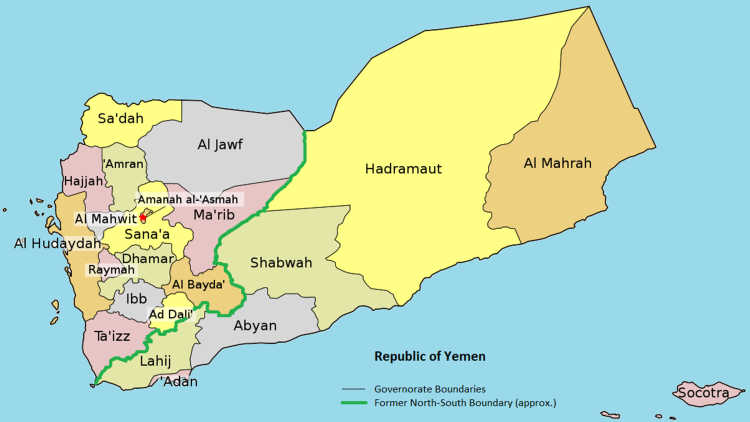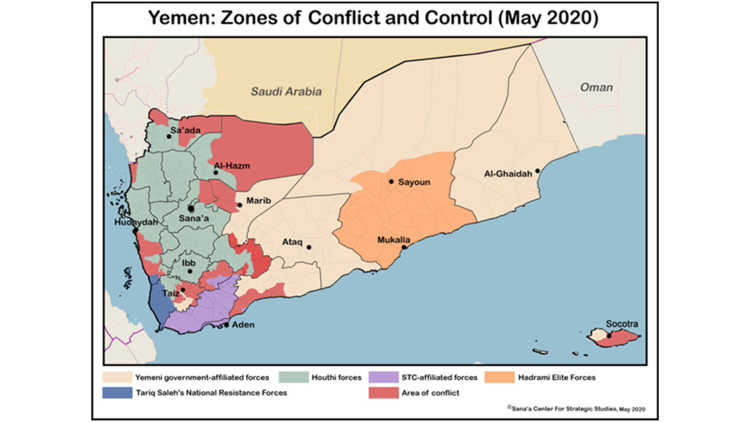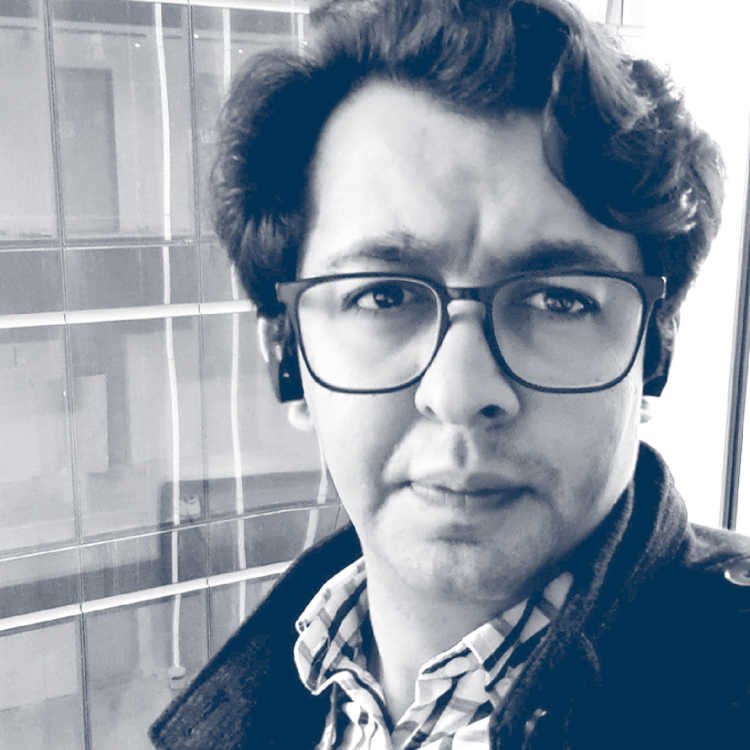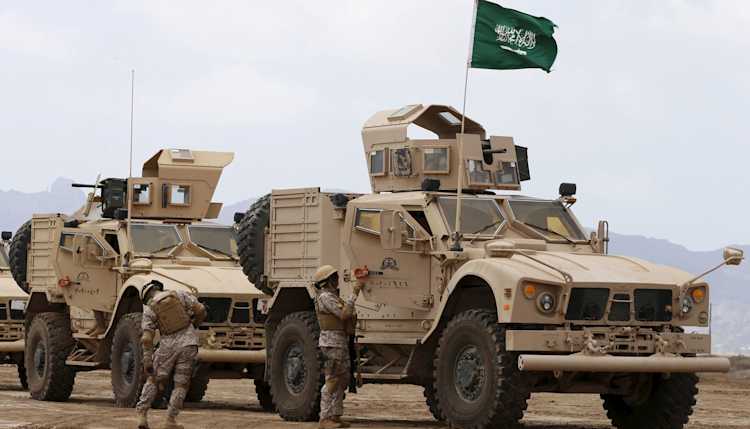- Home
- Publications
- GIGA Focus
- The Future of South Yemen and the Southern Transitional Council
GIGA Focus Middle East
The Future of South Yemen and the Southern Transitional Council
Number 2 | 2021 | ISSN: 1862-3611

The crafting of South Yemen’s political future is a core issue in Yemen’s multilevel conflict. A central role in that process is played by the Southern Transitional Council (al-Majlis al-Intiqali al-Janubi; hereafter, STC), an entity that is increasingly perceived internationally as the representative of South Yemeni interests. While this role is in keeping with the STC’s own mandate, it is not approved of by all of the many rival actors involved.
The STC was founded in 2017 with the aim of leading the territories of the former People’s Democratic Republic of Yemen to independence. Such calls for secession have long been popular with large parts of the population, but have gained new momentum since the onset of civil war in 2014. Reshaping the relationship between North and South has been central to a comprehensive conflict settlement in Yemen, and not just since the STC was founded.
The STC claims to represent the interests of the South and to provide its political leadership. It sees itself at the forefront of the heterogeneous Southern Movement, which has endured numerous internal conflicts since its emergence in 2007 and has not yet been able to agree on a common leadership structure. Thus, the STC is neither the only political interest group of the South nor is its claim to leadership acknowledged and approved of by all organisations of the Southern Movement.
The fact that the STC is currently the dominant organisation in the Southern Movement is largely due to the support of the United Arab Emirates. As a result, the future leadership position of the STC, as well as its agency, are highly dependent on the interests of Abu Dhabi.
Policy Implications
Given the importance of the Southern issue in future peace negotiations in Yemen, it is necessary to take into account the range of key actors in South Yemen and to understand their relationship with each other. The European Union should continue to press for an understanding among these actors and support them in developing a common bargaining position.
The Rise of the Southern Transitional Council
South Yemen’s political future has been the subject of one of the most central – and longest-running – conflicts in Yemen, one that has also had a decisive impact on the course of the war in South Arabia, itself ongoing since 2014. There are a number of reasons why this conflict has long been neither the focus of news coverage regarding Yemen nor that of regional and international mediation efforts. Not least, there has been no actor who has assumed the role, or at least been perceived as playing the role, of representative of Southern interests to the outside world.
This changed with the establishment of the Southern Transitional Council (STC) on 11 May 2017. The fact that the STC is increasingly considered to represent South Yemen is due in part to its clever way of showcasing itself. When it was founded, for example, it referred to the “Historical Declaration” proclaimed several days earlier at a large demonstration in Aden, which, “bearing the will of the people of the South,” authorised Major General Aidarus al-Zubaydi, the later STC chairman, “to assume [...] the administration and representation of the South” and thus its “political leadership” (Nass i’lan ‘adan al-tarikhi 2017). Moreover, the STC now maintains “representations” with the European Union (based in Berlin), the United Kingdom, the United States, and with Canada to manage its external relations.
Second, thanks to significant support from the United Arab Emirates, the STC has succeeded in gaining political supremacy in South Yemen over the past three years as well as considerable leverage at the national level. For example, the Riyadh Agreement ‒ negotiated in Saudi Arabia in November 2019 after months of fighting between forces of the internationally recognised government of President Abdrabbuh Mansur Hadi and the STC’s militias ‒ sees, among other things, equal representation in government, with the STC awarded key portfolios such as the Ministries of Defence and of the Interior. In the renegotiations necessitated by renewed hostilities in May 2020, which culminated in an implementation agreement in December 2020, the STC was able to push through more of its positions.
Even though the new all-Yemeni cabinet began its work in Aden in January 2021, the Agreement is not expected to last very long. The first breaches became apparent within only a few days, when the STC condemned various appointments made by Hadi by presidential decree as a violation of the Agreement and threatened consequences. Nor is there anything to suggest that the STC has abandoned its ultimate goal of achieving independence for South Yemen. Although it withdrew – following Saudi Arabian mediation in July 2020 – the declaration of autonomy that had been proclaimed in April, the STC nonetheless renewed its fundamental demand for Southern secession (Al-Majlis al-Intiqali al-Janubi 2020). Some observers therefore interpret the STC’s participation in the unity government as a strategically necessary detour on the road to the longed-for independence (DeLozier and Bouchlaghem 2020).
The demand for secession is not a unique feature of the STC. Despite the absence of reliable polls, it is safe to assume that large segments of the population in South Yemen are likely to be critical of unity with the North. Other actors and organisations in the Southern Movement (al-Hirak al-Janubi), which emerged in 2007 and from which the STC ultimately emerged, also favour secession – or at least autonomy – for the South. Nevertheless, the STC’s claim to leadership is not unchallenged – nor are its political positions congruent with those of the Southern Movement. Rather, its goals and methods have been sharply criticised by key actors both inside and outside the Southern Movement. Given the importance of the Southern question for Yemen’s future, it is worth taking a close look at the genesis of this intra-Yemeni conflict, the emergence of the Southern Movement, and the STC’s position within it.
From Unification to War
Yemen can look back on 3,000 years of history. In its more recent history, however, it has been divided into a north and south for the longest time. Interrupted by periods of Ottoman rule (most recently 1872‒1918), the north was ruled by a Zaydi Imamate, whose foundations were laid in AD 897 and which was replaced by the Yemeni Arab Republic only after the revolution of 1962 and the end of the ensuing civil war in 1970. In the south, the British occupied the port city of Aden in 1839, founded a crown colony there, and soon controlled most of the south through the Protectorate of Aden. The dividing line between the Ottoman and British spheres of influence, the so-called Anglo-Ottoman Line, roughly demarcated what is now commonly understood as North and South Yemen. After independence from British colonial rule in 1967, the People’s Democratic Republic of Yemen (PDRY; from 1967‒1970, the People’s Republic of South Yemen) would emerge as the only Marxist-oriented state in the Middle East and North Africa (MENA).
Ideologically, but also due to the state-led social-modernisation policy in the South, a competitive relationship developed between the two Yemeni states that was characterised by both military conflict and promises of unity. Shaken by fierce internal power struggles and the drying up of material support from the Soviet Union, the PDRY Politburo was open to unification negotiations in the second half of the 1980s. The North, ruled since 1978 by President Ali Abdullah Salih, was willing to negotiate, being affected just as greatly by the international repercussions of the ending East‒West conflict – in addition to being burdened by internal economic grievances. The decisive factor for both sides was the prospect of developing the oil deposits along the inner-Yemeni border.
On 22 May 1990, the North and South united (see Map 1 below), with the constitution of the newly founded Republic of Yemen providing for a pluralistic democratic system – which “was largely a strategic choice [by the ruling elites] by which each intended to prevent the other from dominating” (Schwedler 2002: 48). Following the same logic, it was agreed that political power would be divided equally between the North and the South until the first free elections were held. The two state administrations initially remained largely intact separately, and the armies of both sides also remained under the respective command of Sanaa and Aden. Salih’s General People’s Congress (al-Mu’tamar al-Sha‘bi al-‘Amm) and its allied Islamist Yemeni Congregation for Reform (al-Tajammu‘ al-Yamani li-l-Islah; hereafter, “Islah”) emerged victorious from the 1993 parliamentary elections. The former unity party of the South, the Yemeni Socialist Party (al-Hizb al-Ishtiraki al-Janubi), came in third. The resulting political dominance of the North led to the rapid deterioration of relations, which eventually resulted in a bitterly fought civil war – the saddest chapter of which was the capture and sacking of Aden in July 1994.

The South’s surrender on 7 July 1994 not only sealed Northern domination but laid the groundwork for the resurgence of the Southern question, insofar as thousands of Yemeni Socialist Party and Southern military members were either expelled or forced into retirement. Numerous former members of the Southern nomenklatura, such as Ali Nasir Muhammad, Haidar Abu Bakr al-Attas, and Ali Salim al-Baydh, provided significant support from exile for the Southern Movement that would emerge more than a decade later. The Southern Movement itself arose from a sit-in by former military officers protesting their forced retirement and denial of an adequate pension in May 2007. Although the Yemeni Socialist Party was not banned, it would suffer marginalisation for several years after large parts of its cadre were expelled and the party’s assets confiscated. It did not regain political importance until a rejuvenated party leadership had decided, in 2005, to formally join an alliance of different opposition parties that included its ideological arch-enemy, the Islamist Islah. This step was rejected by many members of the old guard, who then began to turn away from the party.
The Emergence of the Southern Movement
In the coming years, the Yemeni Socialist Party visibly lost its status as the mouthpiece of South Yemen, while the Southern Movement grew in importance. Originating from a protest by retired officers organised around the figure of Nasir Ali al-Nuba in 2007, it quickly developed into a mass movement that held demonstrations at regular intervals in the major cities of the South. The demands raised on these occasions were initially limited to equal access to state positions and services, political and economic decentralisation, the introduction of (actual) rule of law, and better economic management of the country (Longley and al-Iryani 2008: 2). Calls for Southern secession – initially heard only sporadically, due in part to massive state repression – soon grew louder. With the Arab Spring that began in January 2011, the vision of secession became capable of winning majority support within the Southern Movement.
The Southern Movement is a vivid example of the emergence of a social movement. Conditions such as those initially deplored by the Southern Movement would be found in most regions of the country during the last decade of Salih’s rule. But while grievances exist everywhere, movements do not. Indeed, the emergence of a social movement requires one or more social movement organisations capable of mobilising resources and channelling them accordingly. And, South Yemen had no shortage of competent politicians and former officials who, disillusioned and sidelined, were willing and able to contribute their experience and networks to the nascent Southern Movement – in many places by drawing on the infrastructure of local Yemeni Socialist Party offshoots. Furthermore, a successful social movement needs a common identity that its members can adopt. In the case of the Southern Movement, this identity was formed – especially among its younger representatives – by way of reference to the PDRY’s past statehood. It did so in particular by emphasising the PDRY’s sociopolitical achievements, thereby setting it apart from the North. In addition, whether and to what extent a movement gains adherents depends on its framing processes. For the Southern Movement, this framing was as follows: The problems faced by South Yemenis can be attributed to their oppression by the conservative, backward North. After the South secedes, these problems will vanish into thin air. Secession is therefore not only a desirable but, indeed, also attainable goal.
However, the original problem of the Southern Movement was – and still is – rooted in the multiplicity of its constituent social movement organisations. For example, a number of large groups in Yemen were associated with the Southern Movement already on the eve of the Arab Spring. These included the Higher National Council for the Independence of the South (al-Hay’a al-Wataniyya al-‘Ulya li-Istiqlal al-Janub), led by al-Nuba, who describes himself as the “first founder of the Southern Movement” (al-Nuba n.d.); the Higher National Council for the Liberation of the South (al-Majlis al-Watani al-A‘la li-Tahrir al-Janub), led by Hasan Ba‘um, a former senior PDRY government official from Hadramawt; the Southern Peaceful Struggle Movement (Haraka al-Nidhal al-Silmi al-Janubi), led by Salah al-Shanfara, a former member of the Yemeni Socialist Party faction in the Yemeni parliament, who in 2009 resigned from both the party and his mandate; and, the Leadership Council of the Peaceful Revolution (Majlis Qiyada al-Thawra al-Silmiyya), led by Tariq al-Fadhli, a former associate of Osama bin Laden in Afghanistan and son of the last ruler of the Fadhli Sultanate that had lasted from 1670 up until the establishment of the People’s Republic of South Yemen in 1967.
It is hard to keep track of the exact number of organisations associated with the Southern Movement back then, as well as today. Some were obvious offshoots of larger entities; many, if not most, were politically meaningful only within the narrow confines of the governorate or district level; some dissolved and disappeared completely, whereas others re-emerged under a different name. On occasion, particularly smaller groups would change allegiance vis-à-vis larger ones, or completely merge into other organisations entirely.
The advantages and disadvantages of such organisational diversity are obvious. On the one hand, the repressive Salih regime was unable to put an end to a “snake with a thousand heads” (Dahlgren 2010) in one fell swoop against the leadership. On the other, internal conflicts inevitably arose – especially over fundamental issues such as autonomy or secession. This was evident, for example, during the epochal protests of 2011, when parts of the Southern Movement temporarily joined the protests in the North in the hope that an end to the Salih regime might make secession obsolete. The absence of a unified leadership structure also meant that decisions made by some organisations were not supported by others. During the National Dialogue Conference (2013‒2014), for instance, the mere willingness on the part of some groups to participate in the working group on the Southern question led to fierce controversy within the Southern Movement. The most pressing question then, as now, is therefore not only who legitimately represents the interests of South Yemen but also, and above all, who can be considered the legitimate representative of the Southern Movement.
The United Arab Emirates and the Southern Transitional Council
In retrospect, the National Dialogue Conference proved unsuitable for clarifying central questions concerning the political future of South Yemen. It is also true that the working group’s final recommendations were ultimately made exclusively by a group handpicked by Hadi, namely after certain representatives of the Southern Movement had withdrawn from the body in protest. The articles on the federal reorganisation of the country in the draft constitution of January 2015, pushed through by Hadi, were then also partly responsible for the outbreak of the current war. However, it was the Houthis (Ansar Allah) who would use its publication as an opportunity to overthrow the Hadi government and extend their rule beyond the North. This new civil war then developed into a full-blown conflict drawing in international actors at the latest in March 2015, with the intervention of the military coalition led by Saudi Arabia. This changed the fortunes of the Southern Movement in that it introduced a regional actor, the UAE, that was to usurp the Southern Movement’s secessionist demands.
The UAE has been Saudi Arabia’s most important regional partner since the beginning of the military intervention. In South Yemen, Abu Dhabi became the key player after Emirati military units succeeded in mid-2015 in pushing the Houthis and their allied elements from within the Yemeni army back, first from Aden and then from other areas in the South too. The capture of South Yemen took place as part of Operation Golden Arrow, coordinated with the military coalition, and was hence an important step in the fight against the Houthis from the perspective of Riyadh and the Hadi government. At the same time, control over South Yemeni ports and waters was of particular importance to UAE interests – especially in securing the maritime oil trade and the activities of the logistics company Dubai Ports World, which occupies a central place in the economic-diversification strategy pursued by Abu Dhabi. Accordingly, securing Emirati influence in South Yemen and, related to this, containing rival regional forces such as Iran and Qatar as well as local actors such as Islah, al-Qaeda, and the Islamic State (IS) are among the UAE’s long-term goals.
To achieve this, Abu Dhabi pursued several strategies. First, the Emirates took highly repressive action against those deemed a threat to its own interests. These included al-Qaeda as well as Islah operatives, and critics of the Emirati presence in general. International human rights organisations have accused the UAE of torture, targeted killings, and operating secret prisons in South Yemen for years (Human Rights Watch 2020). Second, various militias trained, equipped, and funded by Abu Dhabi are under direct Emirati control. Estimates put the total number of irregular troops at around 90,000, with the so-called Security Belt Forces (Quwwat al-Hizam al-Amni) at their core. They initially gained notoriety in the fight against al-Qaeda and IS, but most recently in the fierce conflicts with the troops of the Hadi government. Today, the Security Belt Forces are considered the military wing of the STC.
Another essential pillar of Emirati strategy has been cooperation with parts of the Southern Movement. The interests of the two parties overlap to a large extent, especially with regard to their hostility towards Islah – the Yemeni offshoot of the Muslim Brotherhood, whose containment in the MENA is an important component of UAE foreign policy. And although Abu Dhabi has not yet openly advocated the secession of South Yemen, which would run counter to the direct interests of both Saudi Arabia and the US, there is much to suggest that the UAE would ultimately agree to a declaration of independence as long as its own ideological, geostrategic, and economic interests remained protected.
To this end, the UAE played a key role in the establishment of the STC – whose success would be hard to imagine without Abu Dhabi’s involvement. The UAE supports the STC financially and materially alongside hosting many of its leading figures (including al-Zubaydi), whose entry into and exit from South Yemen is thus controlled by Abu Dhabi. Militarily, the STC is also highly dependent on the Emirates, which provides payment for militias allied with the STC and supplied them with heavy weapons, long-range guided missiles, and drones in the 2019 fighting in Abyan with troops of the Hadi government – despite the latter also being Riyadh’s ally (DeLoizier and Bouchlaghem 2020; The New Arab 2020).

Even after the withdrawal of most of its own troops in 2019, the UAE remains the decisive player in South Yemen. For example Abu Dhabi occupies al-Rayan Airport in al-Mukalla, controls key ports (and thus the neuralgic points of South Yemen’s international cargo traffic), and, with Balhaf Port in Shabwa Governorate, runs the country’s only liquefied natural gas terminal. In addition, the Emirates maintain military facilities on the strategically important islands of Perim in the Bab al-Mandab and Socotra in the north-western Indian Ocean; have military supremacy in large parts of South Yemen with de facto command over the militia groups they finance and equip; and, with the STC, steer what is currently the dominant political organisation in the South. However, control over the STC is not synonymous with control over the Southern Movement.
The Position of the Southern Transitional Council within the Southern Movement
Today, while the STC is one of approximately 20 organisations making up the Southern Movement, by no means all of these organisations accept the STC’s claim to leadership. Demonstrations both for and against the STC would already occur in many cities on the occasion of its founding, the latter primarily in the governorates of al-Mahra, Hadramawt, and Shabwa. Even some of the organisations listed on the STC’s website as partner organisations and signatories of the Aden Historical Declaration have made it clear that they do not support the STC (Dunya al-Watan 2017). Leading figures in the Southern Movement, such as al-Nuba, sided with Hadi after the STC took power in Aden or founded new organisations such as Salah al-Shanfara. The STC’s attempts to solicit support from the old Yemeni Socialist Party guard in exile likewise met with only moderate success. While the last president of the PDRY, al-Baydh, openly supported the STC, others – such as his predecessor in office, Ali Nasir Muhammad – kept their distance for example (al-‘Arabi al-Jadid 2018).
The STC’s political dominance in the South Yemeni governorates is closely linked to the Security Belt Forces, which are most active in Abyan, Aden, al-Dhali‘, Lahj, and Socotra. The STC enjoys its greatest support today in al-Dhali‘ and Lahj, although its control there is not complete either (see Map 2 above). For example, one considerable power hub in Lahj is the al-Subayha Resistance (Muqawama al-Subayha), a militia led by Hamdi Shukri al-Subayhi in the west of the governorate. Al-Subayhi, an avowed Salafist and separatist, is also commander of the Second Giants Brigade – a group established and extensively sponsored by the UAE. Although the STC and al-Subayhi cooperated in phases, he never submitted to the STC’s command. In April 2020, heavy fighting even broke out between the al-Subayha Resistance and the Security Belt Forces in Lahj and Aden (al-Khabr al-Yamani 2020).
It is difficult to assess exactly how many actors and organisations in the Southern Movement actually or even formally support the STC today. It is easier to compile the reasons why the STC meets with opposition within the Southern Movement. On the one hand, there are pronounced and persistent regional identities, which, coupled with conflicts within the elite, some decades-old, continue to influence developments in South Yemen today. For example, the STC’s leadership comes primarily from the governorates of al-Dhali‘ and Lahj, while many autonomy advocates – as well as President Hadi and his entourage – are from Abyan. It is, therefore, more than a historical side note that Hadi and Abyan-born Ali Nasir Muhammad belonged to the faction of the Politburo that lost to al-Baydh’s majority Hadramawt group in the South Yemeni civil war of January 1986 and fled to North Yemen. The rival factions are still known today as Zumra and Tughma respectively, both of which can be translated as “group,” although numerous secessionist supporters can be found especially among the former members of al-Baydh’s faction (Tughma).
In addition to the conflict over autonomy or secession, members of the Southern Movement are currently divided over the question of whether to support or reject the Riyadh Agreement – and, related to this, the best choice of means to achieve their goals. The Supreme Council of the Revolutionary Movement for the Liberation and Independence of the South (al-Majlis al-A‘la li-l-Hirak al-Thawri li-Tahrir wa Istiqlal al-Janub) can be seen as an exemplary counterposition to the STC. Although it – like the STC – is in favour of secession, it vehemently rejects the Riyadh Agreement and holds the STC responsible for destroying the peaceful nature of the Southern Movement. Its leader Ba‘um now not only calls the STC an adversary of the Southern Movement but, more importantly, also terms its external supporter – that is, the UAE – an occupying power (‘Adan al-Ghadd 2021). Thus, the opposition that the STC is increasingly confronted with from among large parts of the Southern Movement is driven by a rejection of the UAE – even if only a handful of individuals, such as Ba‘um or Ali Muhammad (Abu Jiyad) al-Sa‘adi, dare to publicly brand the Emirates an occupier. Or, as the writer Bushra al-Maqtari puts it, “without the UAE, there is no Southern Transitional Council, and without the Southern Transitional Council, there is no future for the UAE in South Yemen” (2019).
Implications for Future Peace Negotiations
In his first foreign policy keynote address on 4 February 2021, US president Joe Biden announced a diplomatic offensive to end the war in Yemen and, on the same day, appointed Tim Lenderking the new US Special Envoy to Yemen. Although little concrete information about the US’s latest initiative has emerged so far, the Southern issue is one of the country’s key conflict areas – without it being addressed, comprehensive settlement of Yemen’s multistate conflict will be difficult to achieve. Even if South Yemen’s desire for independence has not yet received official international support, it is obvious that negotiations will in one way or another take account of the de facto partition existing between North and South Yemen. In any case, the participation of Southern Movement representatives in the upcoming negotiations is not only advisable but quite simply necessary. For a peace agreement without their participation would undoubtedly be short-lived, and would inevitably strengthen the secessionists within the Southern Movement.
For this, intra–Southern Movement negotiations in the run-up to later multiparty negotiations will have to take place. The distance between the STC and other actors in South Yemen is too wide for the former to be recognised as representing the South by the majority of the Southern Movement, let alone the majority of South Yemenis. It is therefore necessary for the main representatives of the Southern Movement to agree in advance on a negotiating position. The EU and other international actors have tried in the past to bring representatives of the Southern Movement both at home and abroad to the negotiating table precisely with this goal in mind. These efforts should be pursued and intensified.
Footnotes
References
‘Adan al-Ghadd (2021), Ma mawqif al-hirak al-janubi min ittifaq riyadh? [What is the Southern Movement’s Stance on the Riyadh Agreement?], 11 January, https://www.adengd.net/news/518239/ (5 February 2021).
Al-‘Arabi al-Jadid (2018), Hiwarat abu dhabi: Shahid akhar ‘ala khasa’ir al-infisaliyyin janubi al-yaman [Dialogues in Abu Dhabi: Further Proof of the Secessionists’ Losses in South Yemen], 27 May, https://tinyurl.com/4e6gv3hz (5 February 2021).
Al-Khabr al-Yamani (2020), Quwwat ‘askariyya wa qabaliyya min al-subayha nahw ‘adan li-l-radd ‘ala al-intiqali [Military and Tribal Forces from al-Subayha Targeting Aden in Response to the Transitional (Council)], 12 April, https://alkhabaralyemeni.net/2020/04/12/85540/ (5 February 2021).
Al-Majlis al-Intiqali al-Janubi (2020), Al-mutahaddith al-rasmi li-l-majlis al-intiqali al-janubi yasdir balaghan sahafiyyan hamman [Official Spokesperson of the Southern Transitional Council Issues Important Press Release], 29 July, https://stcaden.com/news/12496 (5 February 2021).
Al-Maqtari, Bushra (2019), Al-yaman… “al-intiqali al-janubi” wa al-murahaqa al-siyasiya [Yemen… “The Southern Transitional (Council)” and the Political Adolescence], in: al-‘Arabi al-Jadid, 9 October, https://tinyurl.com/2uodsfwn (5 February 2021).
Al-Nuba, Nasir Ali (n.d.), Information, in: Facebook, http://tinyurl.com/ohgs8fl (5 February 2021).
Dahlgren, Susanne (2010), The Snake with a Thousand Heads: The Southern Cause in Yemen, in: Middle East Report, 40, 256, 28–33.
DeLozier, Elana, and Zied Bouchlaghem (2020), Riyadh Agreement Redux: Political Gains Still Dogged by Implementation Concerns, in: The Washington Institute for Near East Policy, Policy Watch 3358, https://www.washingtoninstitute.org/policy-analysis/riyadh-agreement-redux-political-gains-still-dogged-imple mentation-concerns (5 February 2021).
Dunya al-Watan (2017), Al-majlis al-a‘la li-l-hirak al-thawri yanfi al-bayan al-mansub lahu [The Supreme Council of the Revolutionary Movement Repudiates the Statement Ascribed to It], 11 May, https://www.alwatanvoice.com/arabic/news/2017/05/11/1048308.html (5 February 2021).
Human Rights Watch (2020), United States: Embargo Arms to the United Arab Emirates, 1 December, https://www.hrw.org/news/2020/12/01/united-states-embargo-arms-united-arab-emirates (5 February 2021).
Longley, April, and Abdul Ghani al-Iryani (2008), Fighting Brushfires with Batons: An Analysis of the Political Crisis in South Yemen, in: The Middle East Institute, Policy Brief 7, https://www.mei.edu/publications/fighting-brushfires-batons-analysis-political-crisis-south-yemen (5 February 2021).
Nass i’lan ‘adan al-tarikhi [Text of the Historical Aden Declaration] (2017), in: ‘Adan al-Ghadd, 4 May, https://adengad.net/news/257659/ (5 February 2021).
Sana'a Center for Strategic Studies (2020), Yemen: Zones of Conflict and Control (May 2020), https://sanaacenter.org/publications/the-yemen-review/10047 (16 March 2021).
Schwedler, Jillian (2002), Yemen’s Aborted Opening, in: Journal of Democracy, 13, 4, 48–55.
The New Arab (2020), UAE gave Yemen’s Separatists Unmanned Drones: Official, 21 November, https://english.alaraby.co.uk/english/news/2020/11/21/uae-gave-yemens-separatists-unmanned-drones-official (5 February 2021).
Wikimedia (n.d.), Governorates of Yemen named, https://upload.wikimedia.org/wikipedia/commons/thumb/8/8c/Governorates_of_Yemen_named.svg/1208px-Governorates_of_Yemen_named.svg.png (22 March 2021).
General Editor GIGA Focus
Editor GIGA Focus Middle East
Editorial Department GIGA Focus Middle East
Regional Institutes
Research Programmes
How to cite this article
Heibach, Jens (2021), The Future of South Yemen and the Southern Transitional Council, GIGA Focus Middle East, 2, Hamburg: German Institute for Global and Area Studies (GIGA), https://nbn-resolving.org/urn:nbn:de:0168-ssoar-72144-3
Imprint
The GIGA Focus is an Open Access publication and can be read on the Internet and downloaded free of charge at www.giga-hamburg.de/en/publications/giga-focus. According to the conditions of the Creative-Commons license Attribution-No Derivative Works 3.0, this publication may be freely duplicated, circulated, and made accessible to the public. The particular conditions include the correct indication of the initial publication as GIGA Focus and no changes in or abbreviation of texts.
The German Institute for Global and Area Studies (GIGA) – Leibniz-Institut für Globale und Regionale Studien in Hamburg publishes the Focus series on Africa, Asia, Latin America, the Middle East and global issues. The GIGA Focus is edited and published by the GIGA. The views and opinions expressed are solely those of the authors and do not necessarily reflect those of the institute. Authors alone are responsible for the content of their articles. GIGA and the authors cannot be held liable for any errors and omissions, or for any consequences arising from the use of the information provided.


















